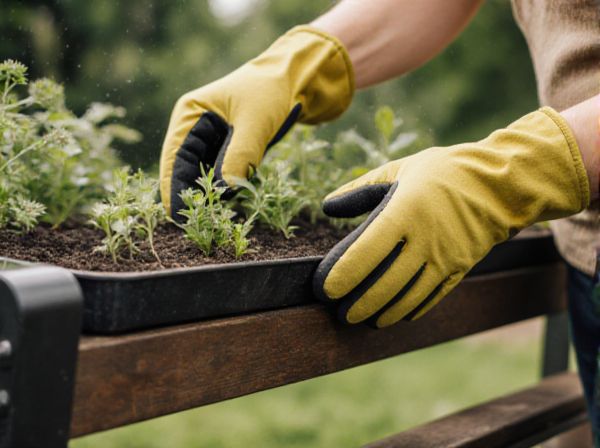
Benching vs in-ground beds Illustration
Benching systems allow for better control over soil quality, drainage, and pest management compared to in-ground beds, making them ideal for diverse plant varieties in greenhouses. In-ground beds utilize the existing soil, which can promote root expansion and natural nutrient absorption but may require more effort to amend and manage soil health. Choosing between benching and in-ground beds depends on factors like crop type, space efficiency, and maintenance preferences within the greenhouse environment.
Table of Comparison
| Feature | Benching | In-Ground Beds |
|---|---|---|
| Structure | Elevated, modular benches | Directly in soil, fixed beds |
| Soil Control | Superior, customizable media | Dependent on native soil quality |
| Drainage | Enhanced drainage systems | Natural soil drainage |
| Accessibility | Ergonomic, easy access | Lower, requires bending |
| Pest and Disease Management | Reduced soil-borne risks | Higher exposure to soil pathogens |
| Flexibility | Modular, easy to rearrange | Permanent layout |
| Cost | Higher initial investment | Lower startup cost |
| Crop Yield | Potentially higher due to optimized growing conditions | Variable, dependent on soil and environment |
Understanding Greenhouse Benching and In-Ground Beds
Greenhouse benching involves elevated trays or tables that improve air circulation, facilitate pest management, and optimize space utilization for seedling propagation and small plants. In-ground beds within greenhouses provide natural soil conditions, enhanced root development, and better moisture retention, making them ideal for larger or deep-rooted crops. Choosing between benching and in-ground beds depends on crop type, greenhouse design, and desired environmental control for optimal plant growth.
Key Differences Between Benching and In-Ground Systems
Benching systems in greenhouses offer elevated growing surfaces that improve airflow and simplify pest management, whereas in-ground beds utilize the native soil, providing natural nutrients and water retention. Benching allows precise control over soil composition and drainage, while in-ground beds depend on existing soil conditions that may require amendments. Temperature regulation is typically easier in benching systems due to separation from cooler ground temperatures, enhancing plant root development and growth cycles.
Pros and Cons of Greenhouse Benching
Greenhouse benching offers improved airflow and easier plant access, reducing soil-borne diseases and allowing for better pest control compared to in-ground beds. Elevated benches enhance drainage and prevent soil compaction, but they require higher initial investment and may limit root expansion for larger crops. Maintenance and irrigation systems are more manageable with benching, though bench height and spacing must be optimized to maximize light exposure and workspace efficiency.
Advantages and Challenges of In-Ground Beds
In-ground beds in greenhouses offer natural soil composition and enhanced root aeration, promoting robust plant growth and reducing soil temperature fluctuations. They pose challenges including potential soil-borne diseases and limited control over nutrient levels compared to raised benches. Proper drainage and soil management are critical to maximize the advantages of in-ground cultivation in controlled environments.
Crop Suitability: Benching vs In-Ground Beds
Benching systems offer controlled conditions ideal for delicate crops such as seedlings, herbs, and leafy greens, enabling precise water and nutrient management. In-ground beds support deep-rooted, heavy-feeding crops like tomatoes, peppers, and root vegetables, benefiting from natural soil ecosystems and enhanced microbial activity. Crop suitability depends on plant root depth, nutrient requirements, and growth stages, optimizing yield and health within greenhouse environments.
Space Efficiency and Layout Considerations
Benching in greenhouses maximizes vertical space by elevating plants, allowing for better air circulation and easier access, thus supporting higher density planting in compact areas. In-ground beds provide natural soil conditions that promote root expansion and nutrient availability but require more horizontal space and careful layout planning to ensure proper drainage and sunlight exposure. Selecting between benching and in-ground beds depends on balancing space efficiency with plant species requirements and greenhouse size constraints.
Soil Management and Fertility Control
Benching in greenhouses offers superior soil management by allowing precise control over fertility through individual bed amendments and easy replacement of soil media, reducing contamination risks. In-ground beds rely on existing soil profiles, which can be more challenging to amend and often require extensive testing and correction of nutrient imbalances to maintain optimal fertility. Controlled nutrient delivery and tailored amendments in benching systems improve crop yield consistency and reduce soil-borne disease incidence compared to traditional in-ground beds.
Watering and Drainage Systems
Benching systems in greenhouses offer controlled irrigation with efficient drip or overhead watering setups that minimize water waste and enhance drainage through elevated platforms. In-ground beds rely on natural soil absorption, requiring well-designed drainage channels to prevent waterlogging and root rot. Optimal watering in benching enables precise water delivery, while in-ground beds demand careful management of drainage to maintain plant health and prevent fungal issues.
Cost Analysis: Initial Setup and Maintenance
Benching systems in greenhouses typically require higher initial setup costs due to materials like metal frames and customizable layouts, but offer reduced soil-related maintenance and better pest control. In-ground beds have lower upfront expenses since they utilize existing soil, though ongoing costs may increase due to soil amendment, irrigation setup, and potential disease management. Long-term cost efficiency depends on crop types and greenhouse scale, with benching favored for intensive, high-value production and in-ground beds suited for larger, less controlled environments.
Choosing the Best Option for Your Greenhouse Gardening
Benching in greenhouses maximizes vertical space and improves airflow, making it ideal for small areas and easier plant management. In-ground beds offer better soil structure and natural drainage, supporting deep root growth and promoting healthier plants. Selecting the best option depends on greenhouse size, plant types, and your gardening goals, balancing convenience with plant health needs.
Benching vs in-ground beds Infographic

 gardendif.com
gardendif.com